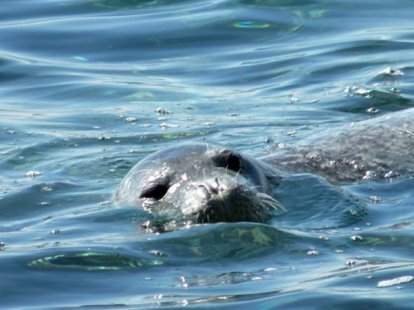
Mediterranean Monk Seal (Photo from the archives of the Mediterranean Monk Seal Group)MONITORING AND RESEARCHING THE MEDITERRANEAN MONK SEAL IN THE MARINE AREA OF PRIMORSKO-GORANSKA COUNTY
The Mediterranean Monk Seal (Monachus monachus) is the
only species of seal living in the Mediterranean Sea. The species was
first scientifically reported in 1779, based on an individual found in
the marine area of Cres Island. The Adriatic Sea has numerous sites –
in particular, underwater caves – that are the species’ favoured habitats,
and many of these sites have been named after this marine mammal. Today,
the Mediterranean Monk Seal is highly endangered, and it is estimated
there are only 350 – 450 individuals remaining in the world, scattered
throughout the Mediterranean Sea in several small populations. Although
the Mediterranean Monk Seal has been officially protected in the Adriatic
since 1935, this did not, unfortunately, stop the species from being hunted,
and the last individual in the Adriatic was killed in 1964. Sporadic sightings
became increasingly rare, and the Mediterranean Monk Seal was thought
to be extinct. In recent years, however, sightings have become more frequent,
and the seal is once again considered to be a permanent habitant of the
Adriatic Sea, particularly the marine area around Cape Kamenjak in Istria
and the Cres-Lošinj archipelago.
This has prompted greater efforts to be made in researching
the Mediterranean Monk Seal in the Adriatic. In the period from 18 March
2010 to 21 March 2011, the caves and habitats of the seal in the marine
area of Primorsko-Goranska County will be monitored and studied. Efforts
will include mapping habitats/caves, collecting data and photo-documentation,
as well as, educating people about this species. The Public Institution
“Priroda” has become involved in this campaign as part of the
project “Monitoring the Mediterranean Monk Seal” headed by the
Mediterranean Monk Seal Group, Association for Wildlife Research and Protection.
The first step will be the publication of a brochure for boaters, describing
endangered and protected marine and coastal species and listing rules
of conduct. One of the most captivating species in the brochure is the
Mediterranean Monk Seal.
What can we do to preserve the Mediterranean Monk Seal in the marine area of Primorsko-Goranska County?
Encountering a Mediterranean monk seal is an extraordinary
experience. How should we behave in such an occasion? Here are a few general
guidelines posted on the Web pages of the Croatian Ministry of Culture,
Directorate for Nature Protection (for detailed information, see link:
www.min-kulture.hr/default.aspx?id=5754):
– How to behave when encountering a Mediterranean monk seal in the sea
Should you sight a Mediterranean Monk Seal while swimming
or diving, be sure to stay still and not to try approach the animal or
make any sudden moves that might disturb it or chase it away. Slowly and
calmly, swim as far away from the animal as you can.
– How to behave when encountering a Mediterranean monk seal in front of or inside a cave
It is prohibited to enter caves listed as potential
habitats and whelping sites of Mediterranean monk seals (competent Public
Institution to inform the public accordingly).
Should you encounter a Mediterranean monk seal while visiting other caves,
stay calm and do not make any sudden moves. Entering deeper into the cave
is not recommended as the seal could become upset and aggressive, especially
if it is a female with a pup. Head back towards the cave entrance, staying
close to the cave wall to prevent the seal from feeling trapped. In this
way, the cave entrance will remain free, enabling the seal to escape if
it feels threatened. Under no circumstances should you attempt to swim
or dive deeper into the cave.
– How to behave when encountering a Mediterranean monk seal on the seashore
Should you spot a Mediterranean monk seal on the seashore,
be sure to stay calm and not make sudden moves. The best thing to do is
find a hiding place from which to observe the animal. If a Mediterranean
monk seal is on land, this does not necessarily mean that it is in need
of human intervention. It could be an individual that is moulting or perhaps
in a deep sleep. If possible, take a photo of the animal and carefully
observe it to estimate it size and note its colour, behaviour and other
details relating to the encounter.
– How to behave in a boat/motor boat encounter with a Mediterranean monk seal
Pleasure rides in boats/motor boats are prohibited in
areas where there have been frequent sightings of Mediterranean monk seals
or where there could be a seal with a pup (competent Public Institution
to inform the public accordingly).
Should you spot a Mediterranean monk seal while riding
in a boat/motor boat, you should stop your vessel and wait until the animal
moves away.
– In all three cases listed above, you should seek to stay at least 50
metres away from the animal.;
– Should you sight a Mediterranean monk seal, please report this to the
Mediterranean Monk Seal Group that will bring all information together
and submit it to the Directorate for Nature Protection of the Ministry
of Culture and to the State Institution for Nature Protection.;
– Should you witness anyone intentionally harassing a Mediterranean monk
seal, please report this to the Directorate for Nature Protection Inspection
and to the local police department.
IMPORTANT CONTACTS
Directorate for Nature Protection Inspection
Rijeka
Ivanka Jelenić, MSc, Senior Inspector
tel: 051/311-302; mob.tel: 098/406-313
e-mail: ivanka.jelenic@min-kulture.hr
State Institute for Nature Protection
tel: 01/5502-900
e-mail: vrste@dzzp.hr
Public Institution ” Priroda”
tel: 051/352-400
e-mail: info@ju-priroda.hr
Mediterranean Monk Seal Group
mob.tel: 098/351-254
e-mail: jasna.antolovic@zg.t-com.hr
Police Department
tel: 92



